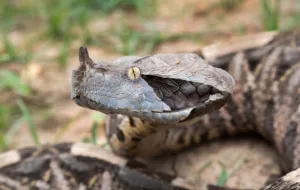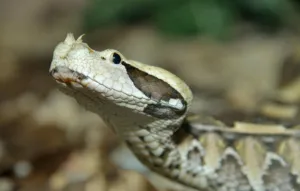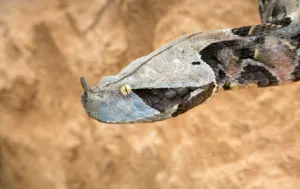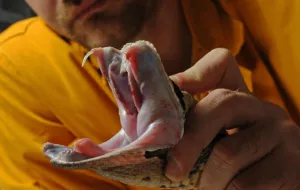
Table of Contents
Scientific Classification
- Kingdom: Animalia
- Phylum: Chordata
- Class: Reptilia
- Order: Squamata
- Suborder: Serpentes
- Family: Viperidae
- Genus: Bitis
- Species: B. gabonica
Quick Overview
The Gaboon Viper (Bitis gabonica) stands as a remarkable and distinctive member of the viper family, renowned for its impressive size, striking appearance, and potent venom. Indigenous to the rainforests and savannas of sub-Saharan Africa, this viper is characterized by its exceptionally long fangs and intricate camouflage patterns.
Fast Facts
- Scientific Name: Bitis gabonica
- Lifespan: Up to 20 years in captivity
- Average Length: 4 to 6 feet (can exceed 7 feet)
- Diet: Carnivorous, primarily small mammals and birds
- Habitat: Rainforests, savannas, and grasslands
Did you know?
The Gaboon Viper’s bite, while potent, is not often fatal to humans. However, the venom can cause severe tissue damage and medical attention is crucial.
Appearance
The Gaboon Viper boasts a distinctive and intricate camouflage pattern, featuring a mix of earthy tones and triangular shapes. Its massive head, adorned with horns or “horns,” further contributes to its unique aesthetic. Despite its intimidating appearance, this viper is typically docile when left undisturbed.
Size and Weight
Known for its substantial size, the Gaboon Viper can reach lengths of 4 to 6 feet, with some individuals exceeding 7 feet. The weight varies, with larger specimens tipping the scales at over 20 pounds.
Temperament and Behavior
The Gaboon Viper is primarily nocturnal, preferring the cover of darkness for hunting. Despite its impressive size, it is known for its relatively slow and deliberate movements. When threatened, it may hiss loudly and strike with surprising speed.
Habitat and Distribution
Indigenous to the rainforests, savannas, and grasslands of sub-Saharan Africa, the Gaboon Viper thrives in diverse ecosystems. Its exceptional camouflage allows it to blend seamlessly into its surroundings.

Care Guide
While not recommended as a pet due to its venomous nature and specific care requirements, proper care for a Gaboon Viper would involve:
- A secure and appropriately-sized enclosure.
- Temperature gradient between 75-85°F.
- Hiding spots and elevated platforms.
- A water source for drinking and soaking.
Diet and Nutrition
In the wild, the Gaboon Viper preys on small mammals and birds. In captivity, a diet consisting of appropriately-sized rodents is suitable.
Health and Wellness
Given their venomous nature, responsible handling is crucially important. Any bite should be treated as a medical emergency. Regular veterinary consultation is necessary for captive specimens.
Breeding
Gaboon Vipers give birth to live young, with litters typically consisting of 20 to 40 offspring. The gestation period is around 6 to 7 months.
Conservation Status
While not currently classified as endangered, habitat loss and human activities pose threats to Gaboon Viper populations. Conservation efforts focus on preserving their natural habitats.
Fun Fact
Despite their potent venom, Gaboon Vipers serve as important components in their ecosystems, participating in controlling rodent populations.
Photo Gallery




Related Profiles
Share This Profile
3 Fascinating Facts About Gaboon Viper
- Fang Mastery: The Gaboon Viper possesses the longest fangs of any snake, reaching lengths of up to 2 inches, allowing for an efficient venom delivery system.
- Camouflage Artistry: Renowned for its intricate camouflage patterns, the Gaboon Viper blends seamlessly into its surroundings, making it a highly effective ambush predator.
- Strike Precision: With an extraordinary strike range, Gaboon Vipers can accurately target prey several inches away, showcasing their impressive hunting abilities.
- Enchi Ball Python: A Unique and Stunning Morph of Python regius - March 27, 2025
- Emerald Tree Monitor: The Enigmatic Green Guardian of the Rainforest - March 26, 2025
- The Egyptian Cobra (Naja haje): A Fascinating Serpent - March 25, 2025
